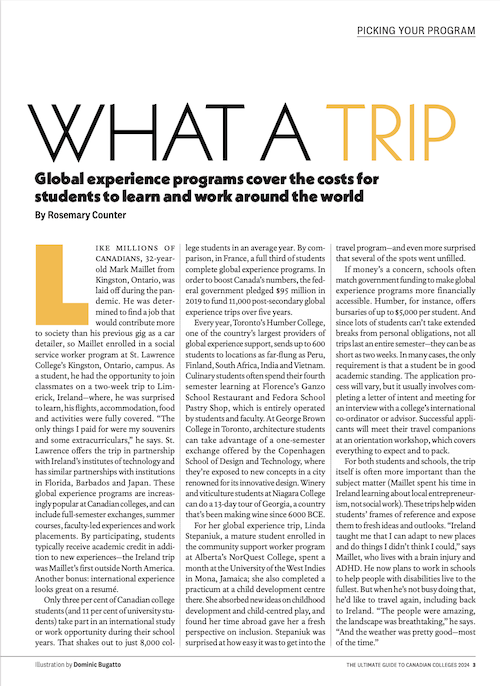What a trip
Global experience programs cover the costs for students to learn and work around the world
Like millions of Canadians, 32-year-old Mark Maillet from Kingston, Ontario, was laid off during the pandemic. Determined to find a job that would contribute more to society than his previous gig as a car detailer, Maillet enrolled in a social service worker program at St. Lawrence College’s Kingston, Ontario, campus. As a student, he had the opportunity to join classmates on a two-week trip to Limerick, Ireland—where, he was surprised to learn, his flights, accommodation, food and activities were fully covered. “The only things I paid for were my souvenirs and some extracurriculars,” he says.
St. Lawrence offers the trip in partnership with Ireland’s institutes of technology and has similar partnerships with institutions in Florida, Barbados and Japan. These global experience programs are increasingly popular at Canadian colleges, and can include full-semester exchanges, summer courses, faculty-led experiences and work placements. By participating, students typically receive academic credit in addition to new experiences—the Ireland trip was Maillet’s first outside North America. Another bonus: international experience looks great on a resumé.
Only three per cent of Canadian college students (and 11 per cent of university students) take part in an international study or work opportunity during their school years. That shakes out to just 8,000 college students in an average year. By comparison, in France, a full third of students complete global experience programs. In order t boost Canada’s numbers, the federal government pledged $95 million in 2019 to fund 11,000 post-secondary global experience trips over five years.
Ever year, Toronto’s Humber College, one of the country’s largest providers of global experience sports, sends up to 600 students to locations as far-flung as Peru, Finland, South Africa, India and Vietnam. Culinary students often spend their fourth semester learning at Florence’s Ganzo School Restaurant and Fedora School Pastry Shop, which is entirely operated by students and faculty. At George Brown College in Toronto, architecture students can take advantage of a one-semester exchange offered by the Copenhagen School of Design and Technology, where they’re exposed to new concepts in a city renowned for its innovative design. Winery and viticulture students at Niagara College can do a 13-day tour of Georgia, a country that’s been making wine since 6000 BCE.
For her global experience trip, Linda Stepaniuk, a mature student enrolled in the community support worker program at Alberta’s NorQuest College, spent a month at the University of the West Indies Mona, Jamaica; she also complete4d a practicum at a child development centre there. She absorbed new ideas of childhood development ad child-centred play, and found her time abroad gave her a fresh perspective on inclusion. Stepaniuk was surprised at how easy it was to get into the travel program—and even more surprised that several of the spots went unfilled.
If money’s a concern, schools often match government funding to make global experience programs more financial accessible. Humber, for instance, offers bursaries of up to $5,000 per student. And since lots of students can’t take extended breaks from personal obligations, not all trips last an entire semester—they can be as short as two weeks. In many cases, the only requirement is that a student be in good academic standing. The application process will vary, but it usually involves completing a letter of intent and meeting for an interview with a college’s international co-ordinator or advisor. Successful applicants will meet their travel companions at an orientation workshop, which covers everything to expect and what to pack.
For both students and schools, the trip itself is often more important than the subject matter (Maillet spent his time in Ireland learning about local entrepreneurism, not social work). These trips help widen students’ frames of reference and expose them to fresh ideas and outlooks. “Ireland taught me that I can adapt to new places and do things I didn’t think I could,” says Maillet, who lives with a brain injury and ADHD. He now plans to work in schools to help people with disabilities live to the fullest. But when he’s not busy doing that, he’d like to travel again, including back to Ireland. “The people were amazing, the landscape was breathtaking,” he says. “And the weather was pretty good—most of the time.”
